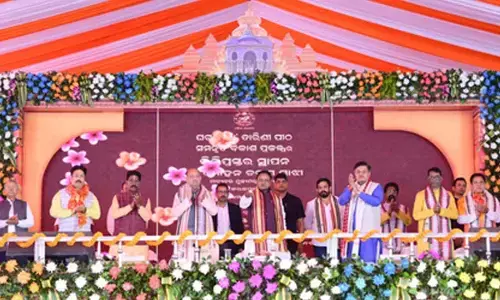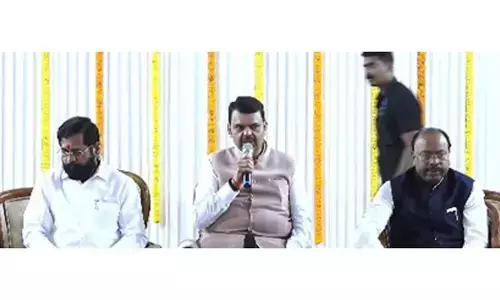The Timeless Marvels of Gwalior Fort

Discover the enduring splendour of Gwalior Fort, a timeless marvel blending Rajput, Mughal, and Hindu architecture, standing proudly amidst the tales of valour and history
We stand in the bitter cold, shivering on the ramparts of Gwalior Fort to capture its grandeur at sunrise. Huddled for warmth, our endless wait yields nothing but a cloudy sky: while some get into vigorous workouts to drive away the wintry chill the others look out for a hot cup of tea. At last, the dawn breaks, the first golden sunrays fall on the majestic Gwalior Fort to expose a bronze and blue edifice, a timeless beauty whose magnificence often overwhelms the layman and the historian alike.
Our guide Mohd Razvi, a fourth-generation guide delves into the story of Gwalior: according to the legend, a 3rd century Rajput chieftain named Suraj Sen, who was suffering from leprosy was cured by a holy man called Gwalipa, who offered him water from a sacred pond which now lies within the fort. Suraj Sen built the town and fort and in gratitude, named the city after Gwalipa.
Gwalior Fort
Built in the 8th century, Gwalior Fort with 35-foot-high, 3.2 km long outer walls earned the reputation of one of India’s most impregnable forts. Made of sandstone, it is a blend of Rajput, Mughal, and Hindu architectural styles; boasts three temples, six palaces, and several water tanks. The outer walls of the fort display beautiful motifs like ducks, crocodiles, and elephants made of yellow and blue tiles that lend supreme charm and elegance to the structure. Raja Man Singh Tomar (ruled from 1486-1516) imported from distant lands like Persia, Samarkand and Bukhara, the blue glazed tiles that give a distinctive look to the fort.
Man Mandir Palace
A great patron of architecture and music, the Tomar ruler created this four-storeyed Man Mandir Palace in the fort, elegantly designed with six round towers crowned with domed cupolas. It has two open courtyards surrounded by rooms with ceilings of various designs. The rooms are decorated with fine perforated screens, beautiful pendants, cornices, mouldings, and geometrical and floral patterns. In the “Jhoola Ghar” situated in the basement, Man Singh’s eight queens could swing simultaneously, while enjoying sunshine during the day and moonlight in the night, thrown up through the cleverly placed openings. The “Kesar Kunda” was used for their bathing and beauty treatments. It is in one of these cellars that Aurangzeb imprisoned his brother Murad and killed him later in 1661to usurp the throne.
In the Chaturbhuj Temple, the depiction of zero (India’s contribution to the world) can be seen. There are other monuments like Jehangir Mahal, Shah Jahan Mahal and Gujari Mahal in the palace complex. Nearby Jauhar Kund is the place where various Rajput women committed mass suicide when Iltutmish (of the Delhi Sultanate) seized the fort in the 13th century CE. Rani Laxmi Bai of Jhansi took refuge in this Gwalior Fort and died fighting the British.
Saas Bahu Temple
The Saas Bahu Temple, located in the Eastern corner of Gwalior Fort, is a twin temple complex built around 1093. The original name was derived from Sahastrabahu, meaning a thousand arms (of Lord Vishnu). The larger Saas temple, dedicated to Lord Vishnu, features open galleries, exuberantly carved pillars, and intricate exterior walls with floral and geometric designs. Mughal ruler Babur’s attack in 1527 damaged the temple’s tower and sanctum and defaced the idols, but the architecture and carvings still reveal their beauty in ruins. The smaller Bahu temple, dedicated to Shiva, mirrors the exterior decoration and showcases an image of damaged Vishnu alongside Brahma and Shiva.
Teli Ka Mandir
Among the hill-fort’s many temples, Teli Ka Mandir stands out with its unique Dravidian style wagon-vaulted roof. Built over a thousand years ago, with donations given by oil merchants during the reign of King Mihira Bhoja of the Prathihara dynasty, this temple dedicated to Shiva, Vishnu, and Matrikas (Shakti) displays extensive exterior sculptures, though the inner sanctum is empty. Despite damage from Muslim invasions, the towering Teli Ka Mandir remains a testament to ancient craftsmanship and devotion, rising over 100 feet in height.
As we climb down the Gopanchal hill, we see naked statues (true to the style of Jain iconography) of the Jain Tirthankaras carved into the rock face. Though they stand defaced and disfigured today, the unruffled spiritual leaders seem to hold the key to a peaceful world!


















